Bench Press for Women: Techniques for Powerlifters
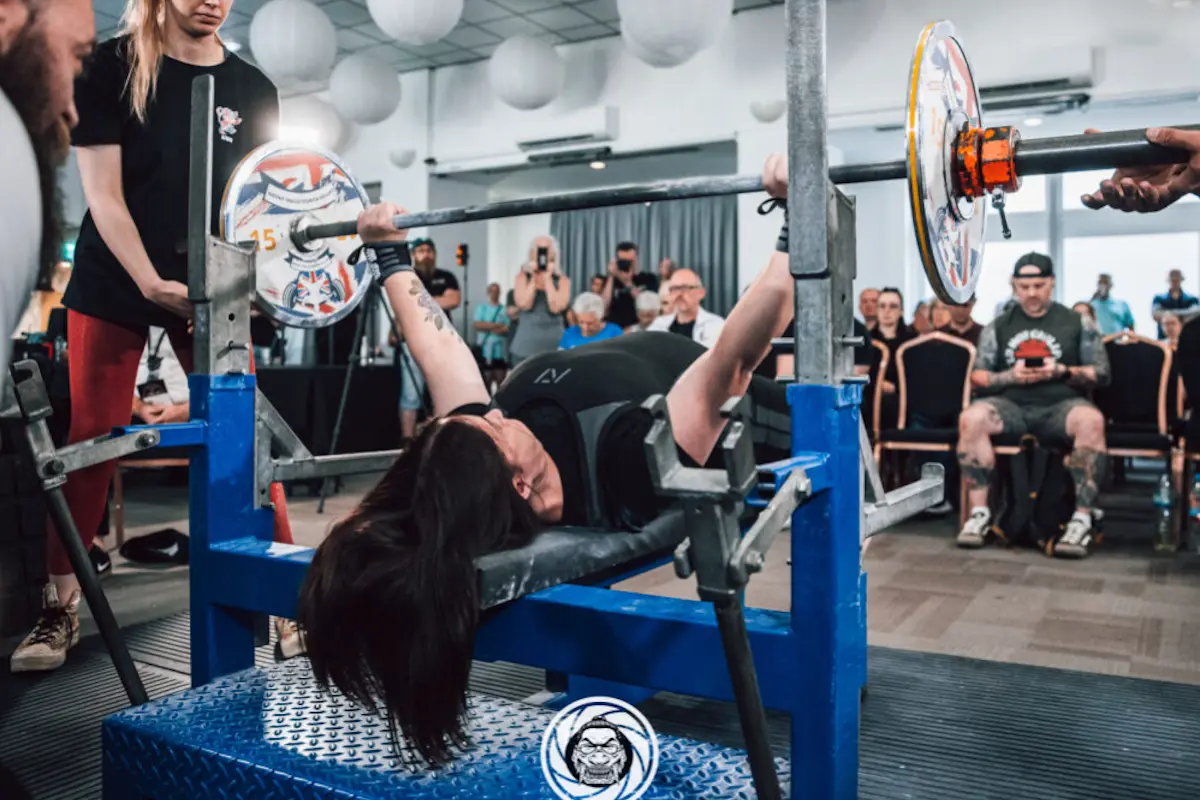
What's In This Article
- Key Highlights
- Introduction
- Lifter's Guide to the Bench Press
- Differences for Female Powerlifters
- Bench Press for Women Technique Guide
- Training Considerations
- Avoiding and Managing Injuries
- Using Equipment Effectively
- Conclusion
- Frequently Asked Questions
- References
- Resources
Key Highlights
- Full-body tension and leg drive are essential for maximizing bench press power.
- Progressive overload requires systematic increases in weight, reps, or sets.
- This lift engages multiple upper body muscles for comprehensive strength development.
- The proper form demands straight wrists, aligned elbows, and planted feet.
- Accessory exercises strengthen supporting muscles and address weak points.
Introduction
The bench press is crucial in powerlifting. It tests upper body strength by engaging many muscles. However, it has become more than a chest exercise; it has evolved into a complex technique requiring precise form, especially in competitive powerlifting.
This lift holds special importance for women powerlifters, providing a platform to display their upper body strength and challenge stereotypes in strength sports. This lift promotes muscle growth and allows women to excel in the sport, historically dominated by men.
Dr Emma Ylitalo-James, Jennifer Thompson, and Kimberly Walford are renowned female powerlifters who have become icons in the sport by achieving remarkable feats in bench pressing and other lifts. Their success stories inspire women everywhere and challenge the outdated notion that powerlifting is a male-dominated sport.
After years of struggling with my own bench press as a female powerlifter competing nationally and internationally, I understand women's unique challenges with this lift. As an athlete who's overcome plateaus and now a coach helping others do the same, I've learned that addressing women's specific needs and body characteristics is crucial for success.
Lifter's Guide to the Bench Press
Anatomy of the Barbell Bench Press
Muscles Involved
- The bench press is a key upper-body movement involving various muscles.
- It mainly targets the chest (pectoral) muscles.
- Additionally, it works the shoulders (deltoids), arms, and upper back muscles (trapezius and latissimus dorsi).
- These muscles work synergistically to lift the bar and stabilize the position.
Biomechanics of the Movement
- Biomechanically, the bench press is a complex movement. It involves the dynamic interaction of various joints, primarily the shoulder and elbow joints.
- During the descent, or the eccentric phase, the pectoral and upper back muscles stretch, storing elastic energy.
- The concentric phase, or the lift, sees the explosive contraction of these muscles, particularly the chest and triceps, to push the bar upwards.
- A crucial aspect is maintaining a bar path that aligns with the natural motion of the arms, ensuring the force is optimally distributed across the involved muscles and joints.
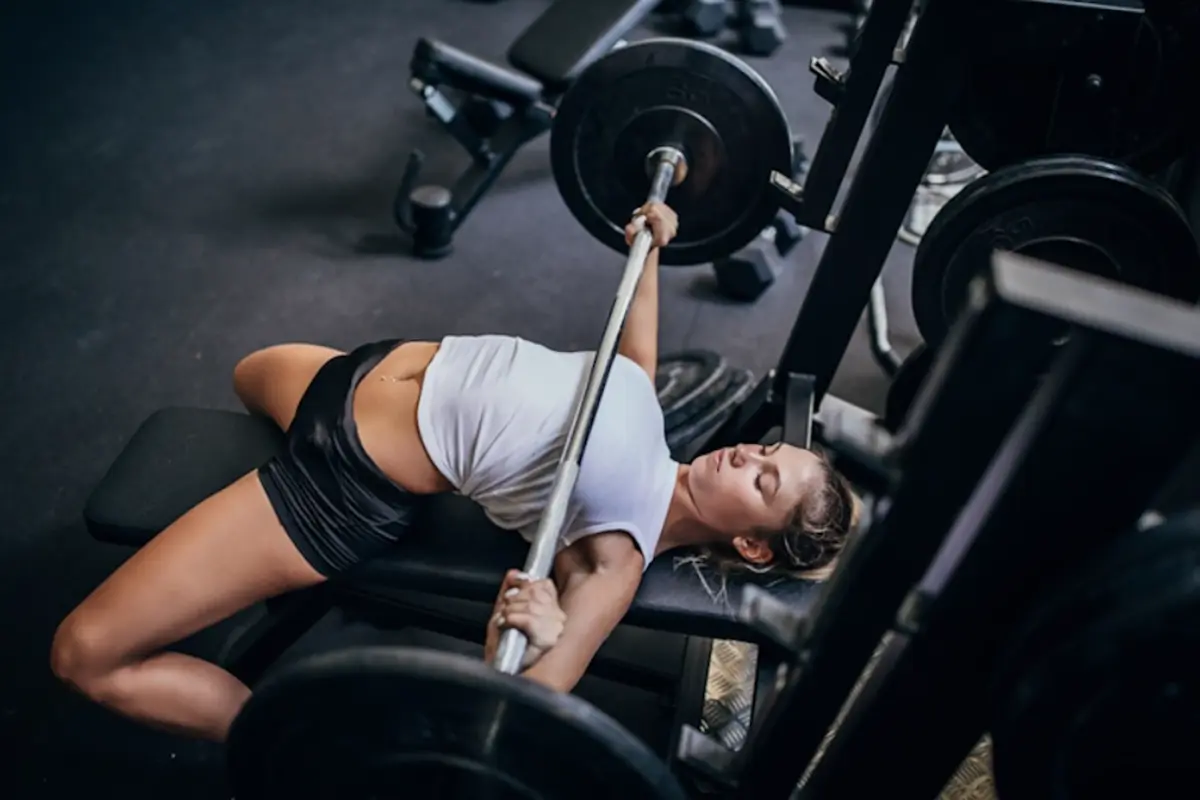
Differences for Female Powerlifters
Physiological Considerations
In female powerlifting, the role of physiological factors is substantial and multifaceted.
- Women typically have a wider pelvis, which can affect their lower body mechanics and indirectly impact their bench press technique.
- Additionally, the distribution of body fat in women, which is generally higher than in men, can influence body composition and strength-to-weight ratio, crucial factors in powerlifting performance (Mansour et al., 2021).
- Hormonal fluctuations, particularly the variations in estrogen and progesterone levels throughout the menstrual cycle, can impact joint laxity, energy levels and pain perception. Awareness of these cyclic changes can be pivotal in planning training schedules, intensity, and recovery periods.
Common Challenges and How to Overcome Them
- Women often encounter specific challenges in bench pressing, including the relative upper body strength-power deficit (Junior et al., 2024; Amasay et al., 2016; Bartolomei et al., 2021).
- There is some research to dispute this. A 2018 paper by Olsson et al. found that men demonstrated greater absolute strength in 10RM bench press, but when normalized to fat-free mass, there was no difference in relative upper body strength between sexes.
- Movements like push-ups, overhead presses, and rows can bolster the strength of the deltoids, triceps, and upper back, contributing to a more robust lift. These exercises enhance muscle strength and improve neuromuscular coordination, critical for executing complex compound movements like the bench press.
- Elbow positioning is another critical factor. Keeping the elbows too flared can strain the shoulders, and tucking them excessively can shift undue stress to the triceps. Finding a balanced angle that complements body mechanics is critical.
- Grip width adjustments can provide significant mechanical advantages or disadvantages. A narrower grip emphasizes tricep engagement, which benefits lifters with strong arms. In comparison, a wider grip can reduce the range of motion, which is advantageous for those with shoulder flexibility limitations.
- Maintaining body tightness throughout the lift is essential. This involves creating tension in the body before the lift, which aids in injury prevention and power generation.
- Techniques like the 'leg drive', where the lifter uses their legs to generate additional force, can be particularly beneficial. It's about channelling the strength from the entire body, not just the upper body, to execute the lift.
Understanding and adapting to these physiological and biomechanical factors can help you achieve a good bench press performance. It's about embracing these differences, using them to your advantage, and persistently working towards refining technique and strength. This approach enhances performance and fosters a deeper appreciation for the unique aspects of female powerlifting.
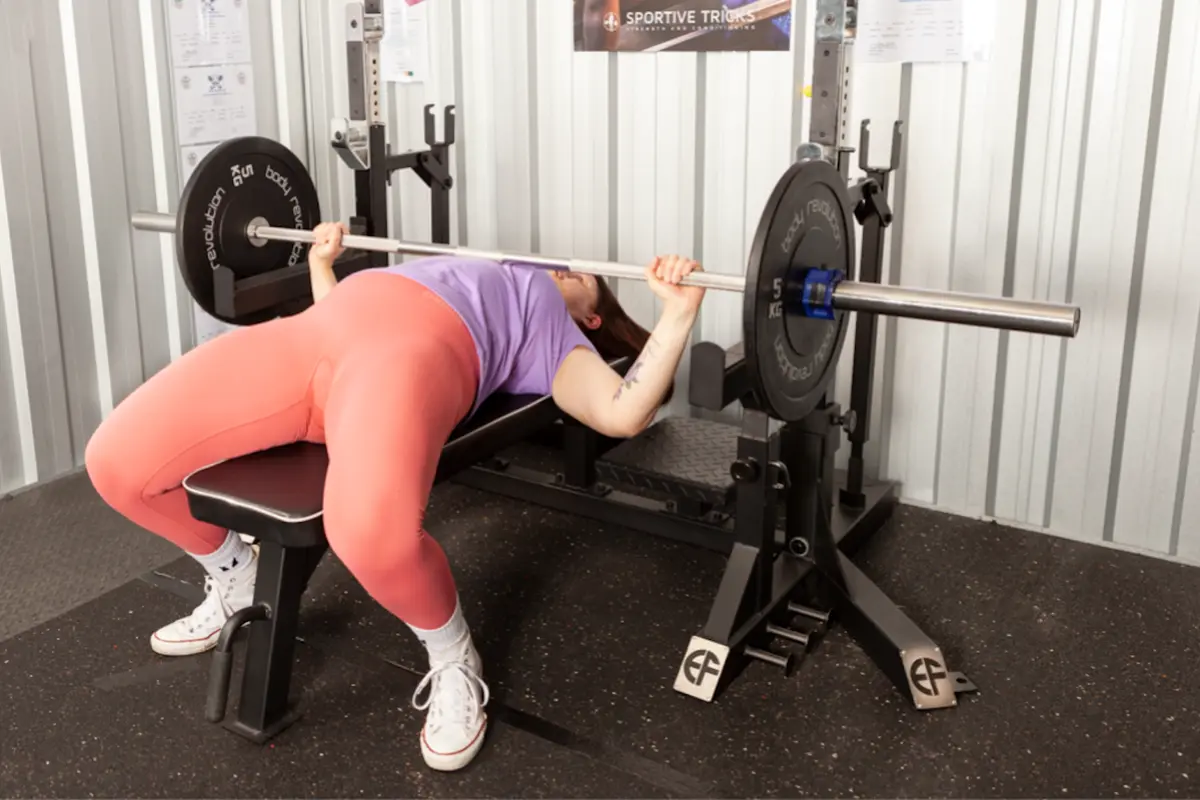
Bench Press for Women Technique Guide
Setup and Positioning
Hand Placement and Grip
- The foundation of a powerful press begins with proper hand placement and grip.
- Grip width can vary, but a medium grip, where the forearms are perpendicular to the floor at the bottom of the lift, is often recommended for balancing force and minimizing injury risk.
- The wrists should remain straight, and the bar should be aligned with both the wrists and elbows to create an efficient force transfer.
Body Alignment: Feet and Hips
- A stable and aligned body is crucial for an effective press.
- Feet should be planted firmly on the floor, creating a stable base.
- This positioning helps maintain a tight lower body. It helps generate leg drive, a key component in lifting heavier weights.
- The hips should remain in contact with the bench throughout the lift, ensuring a stable pelvis and lower back.
Arching the Back: Benefits and Safe Practices
- Arching the back is a common and beneficial practice in powerlifting technique.
- It reduces the range of motion, potentially allowing for lifting more weight.
- More importantly, it helps plant the shoulder blades, creating a stable platform for the upper back and reducing the risk of shoulder injuries.
- However, the arch must be safe and comfortable, focusing on retracting and depressing the shoulder blades rather than excessive lumbar extension.
Stefanie Cohen, the first female to pull a quadruple bodyweight deadlift, emphasizes the benefits of arching during bench press. She explains that arching engages the pecs more and reduces shoulder involvement, as the pec is a stronger and larger muscle. Cohen notes that women are generally more flexible than men, making it easier for them to arch.
The Lift
Descent: Controlling the Bar
- The descent phase is about control and precision.
- The bar should move straight, descending slowly and steadily to the lower chest.
- Keeping the elbows tucked (at about a 45-degree angle to the body) can help maintain shoulder health and optimize the use of pectoral muscles.
The Pause: Maintaining Tension and Stability
- A brief pause at the bottom of the lift is a requirement in powerlifting competitions and is a technique to build strength.
- This pause eliminates momentum, forcing the lifter to maintain body tightness and complete control of the bar.
Ascent: Driving the Bar Up
- The ascent is the phase where the bar is pressed back to the starting position.
- This requires a coordinated effort of the chest, triceps, and shoulders.
- Driving the feet into the floor, pressing the upper back into the bench, and explosively contracting the chest muscles are key to effectively lifting the bar.
Breathing and Bracing
Importance of Proper Breathing
- Proper breathing technique is fundamental in bench pressing.
- Inhaling deeply before the descent and holding the breath stabilizes the core and thoracic spine, providing a solid base from which to press.
Techniques for Effective Bracing
- Effective bracing involves creating tension throughout the body, especially the core, to support the spine and transfer force efficiently.
- This is achieved by taking a deep breath into the abdomen (not just the chest) and then tightening the abdominal muscles as if preparing for a punch.
- This technique enhances stability and safety, particularly for the lower back.
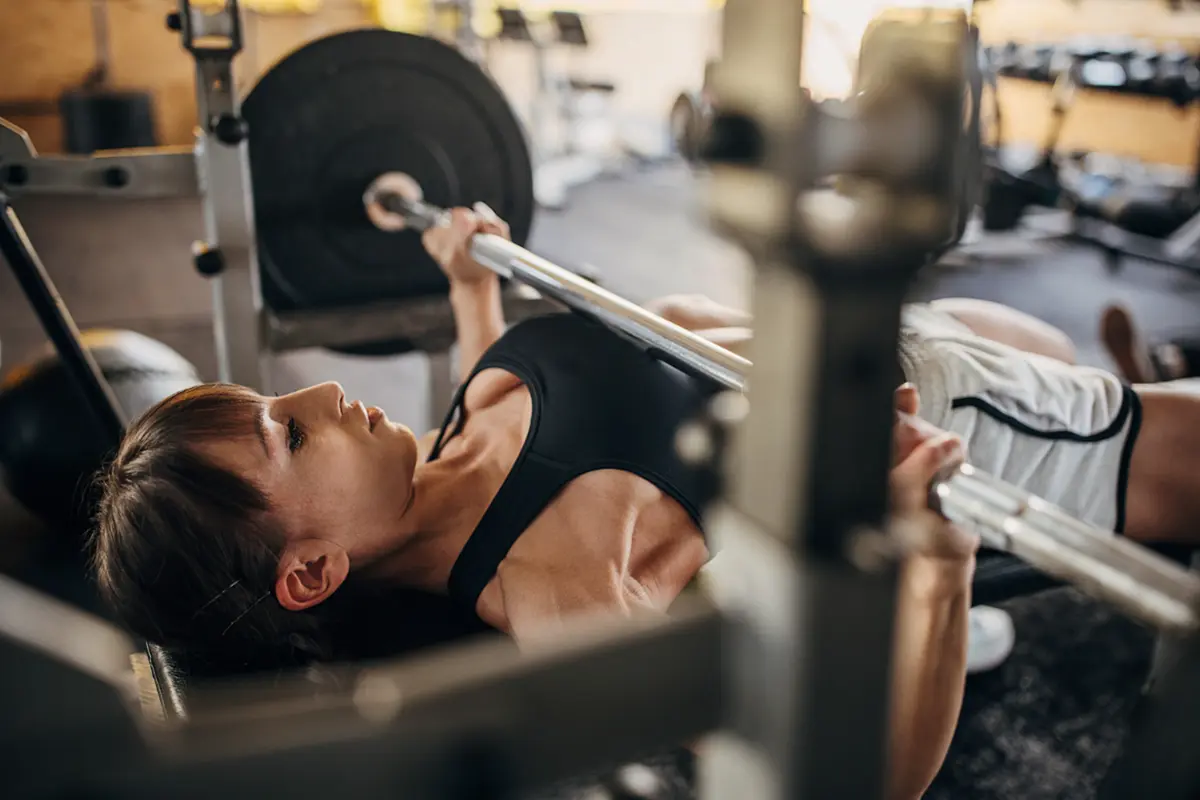
Training Considerations
Developing a Bench Press Program
Frequency and Volume
- Balancing frequency and volume is the key to a successful bench press program.
- Frequency refers to how often you bench press in a week, while volume is the total number of reps and sets.
- For most lifters, bench pressing 2-3 times weekly allows for adequate muscle recovery and growth.
- Volume should be adjusted based on experience level and training goals, focusing on gradually increasing workload to stimulate muscle growth and strength gains without causing overtraining.
Progressive Overload Principles
- Progressive overload, a fundamental principle in strength training, involves continuously increasing the demands on the musculoskeletal system to gain muscle mass, strength, and endurance.
- In bench pressing, this can be achieved by gradually increasing the weight lifted, altering the number of repetitions and sets, or modifying rest intervals.
- It's crucial to increase the load systematically and safely to challenge the muscles while minimizing the risk of injury.
Accessory and Dumbbell Exercises: Upper Body Strength
Strengthening Synergistic Muscles
- Accessory exercises are essential for strengthening muscles that assist in the bench press, known as synergistic muscles.
- Exercises like the dumbbell bench press, shoulder press, and triceps extensions specifically target the shoulders, triceps, and upper back, respectively.
- These movements help develop balanced muscle strength, which is crucial for a strong bench press.
Addressing Weaknesses
- Identifying and addressing individual weaknesses is crucial.
- For instance, if the lockout phase of the bench press is challenging, incorporating exercises like board presses or floor presses can be beneficial.
- If maintaining shoulder stability is an issue, exercises that strengthen the rotator cuff and improve shoulder joint integrity should be included.
Julia Ladewski, a powerlifter and strength coach with 24 years of experience, demonstrates the importance of shoulder strength in bench pressing. She can bench over her body weight for reps and use 70-pound dumbbells on the flat bench, highlighting the significance of well-developed shoulders for strong pressing in all directions.
Periodization and Peaking
Planning Training Cycles
- Periodization involves structuring training into phases with specific goals, such as building muscle mass, strength, or power.
- This approach allows for systematic progression in training intensity and volume.
- For bench press improvement, a periodization plan might start with a phase focused on building muscle mass (hypertrophy), followed by a strength phase. Finally, there is a power phase as one approaches a competition or peak performance period.
Tapering for Competition
- Tapering reduces training volume in the weeks leading up to a competition.
- This allows the body to recover fully and consolidate strength gains.
- Tapering strategies might include reducing the number of sets and reps while maintaining or slightly increasing the weight lifted, ensuring the lifter is fully recovered and primed for optimal performance on competition day.

Avoiding and Managing Injuries
Common Bench Press Injuries
Shoulder Pain and Rotator Cuff Issues
- For female powerlifters, the risk of shoulder injuries, including rotator cuff issues, can be heightened due to differences in shoulder anatomy and muscle mass distribution compared to their male counterparts.
- Women generally have a narrower shoulder width, which can affect their bench press mechanics, potentially leading to improper form and increased risk of injury.
- These anatomical differences compound the instability of the shoulder joint, necessitating a more cautious approach to the flat bench press technique. This is particularly true for managing elbow flare and grip width to safeguard against undue stress on the rotator cuff.
Elbow and Wrist Strain
- Elbow and wrist strains are particularly concerning for female powerlifters, who might experience these issues more frequently due to joint structure and muscle mass differences around these areas.
- Ensuring proper alignment and muscle support during the lift is crucial. This involves correct positioning and developing the surrounding musculature, which can provide better support and reduce strain on these joints.
Preventative Strategies
Warm-up Routines
- Warm-up routines are essential as they prepare the muscles and joints for the demands of bench pressing.
- These routines should be tailored to address the specific needs of female athletes, considering their joint mobility and muscle activation patterns.
- Exercises that focus on shoulder stability and mobility can be particularly beneficial, given the shoulder area's susceptibility to injury.
Proper Technique and Form Adjustments
- Adhering to proper bench press form is even more crucial for female powerlifters.
- Due to typical differences in upper body strength and body structure, women may benefit from specific form adjustments.
- For example, a slightly narrower grip can reduce strain on the shoulder joint while ensuring that the elbows are not overly tucked or flared. This can help maintain a balanced load across the shoulder and elbow joints.
Advanced Strategies and Techniques
Close-grip Bench Press
- The close-grip bench press is a variation that primarily targets the triceps while still engaging the chest and shoulder muscles.
- In this variation, the hands are placed closer together on the bar, typically shoulder-width apart.
- This grip shifts the focus more towards the triceps, making it an effective exercise for developing upper arm strength, which is crucial for the lockout phase of the bench press.
Incline and Decline Bench Press
- The incline bench press is performed on an inclined bench, which shifts the focus towards the upper chest (pectoralis major) and shoulders. This variation is beneficial for developing the upper pectoral muscles, leading to a more balanced chest development.
- The decline bench press, performed on a declined bench, targets the lower part of the chest muscles. These variations add diversity to the training regimen and ensure comprehensive development of the chest muscles.
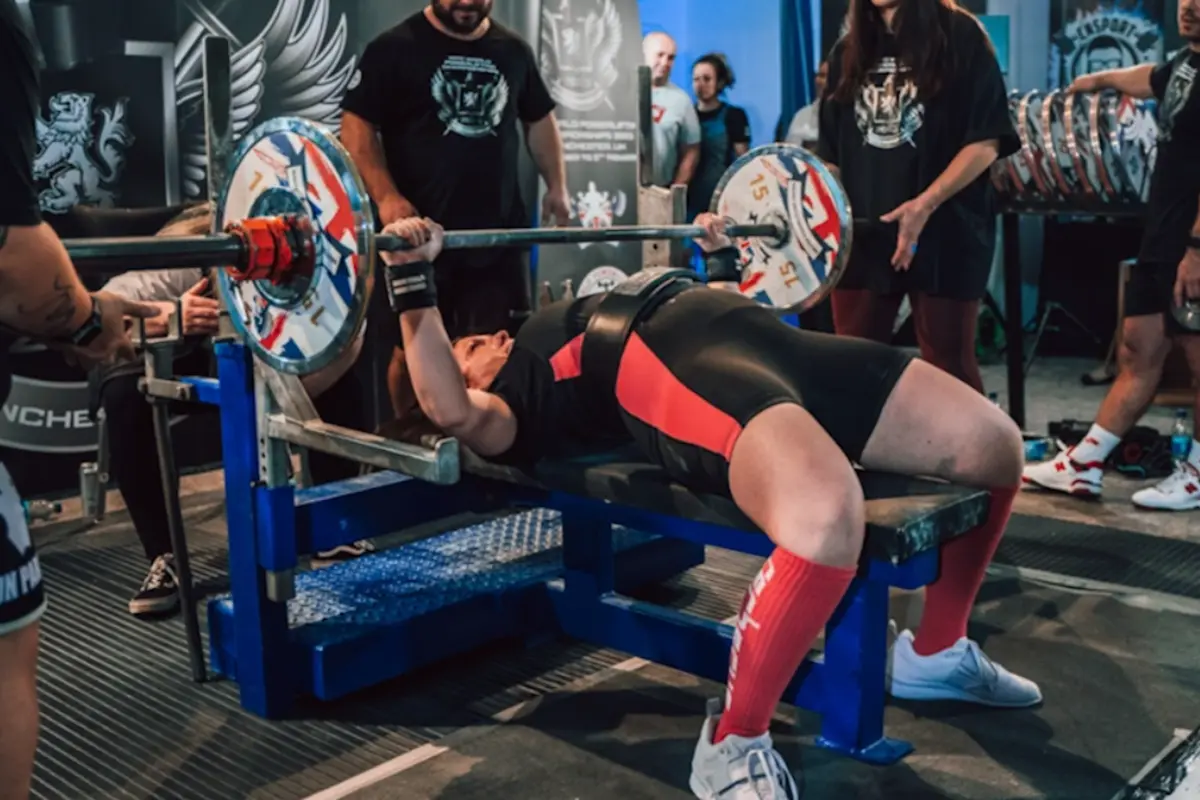
Using Equipment Effectively
Wrist Wraps and Belts
- Wrist wraps support the wrists, especially when lifting heavier weights.
- They help keep the wrists straight and aligned with the forearm, reducing the risk of strain or injury.
- While lifting belts are less common in bench pressing than in squats or deadlifts, they can enhance core stability, especially for lifters with lower back issues.
Bench Press Shirts
- Bench press shirts are specialized equipment used primarily in equipped powerlifting competitions.
- They are made of stiff material that adds significant resistance in the eccentric phase of the lift, helping to store kinetic energy that can be released during the lift.
- While they allow lifters to press more weight, bench shirts require technical proficiency and alter the natural movement pattern of the bench press. This makes them less suitable for general strength training and more appropriate for advanced competitive powerlifters.
Conclusion
The anatomy, muscles used and proper execution of the bench press for women should be embraced and understood. Emphasis should be placed on learning a solid setup, position, and technique for improved performance and injury prevention.
Training tips include creating a balanced program, adding accessory exercises, and using periodization for gains. Preventing injuries and rehab strategies are crucial in training safely.
Bench pressing is not just physical but also about empowerment for female powerlifters. It symbolizes strength, determination and perseverance in a lift traditionally associated with men.
Frequently Asked Questions
How should women adjust their bench press grip width?
A medium grip width where the forearms are perpendicular to the floor at the bottom of the lift is generally recommended. This balances force generation while minimizing injury risk. Women may benefit from a slightly narrower grip than men due to anatomical differences in shoulder width.
How often should women bench press for optimal results?
For most lifters, bench pressing 2-3 times per week is optimal. This frequency allows adequate muscle recovery and growth time while maintaining consistent progress. The exact frequency should be adjusted based on individual experience level and training goals.
Why is back arching important in powerlifting bench press?
Back arching serves two key purposes: it reduces the range of motion (potentially allowing for heavier lifts) and helps align the shoulder blades to create a stable platform for the upper back. However, the focus should be on retracting and depressing the shoulder blades rather than excessive lumbar extension.
What are women's most common bench press injuries, and how can they be prevented?
Women are particularly susceptible to shoulder pain and rotator cuff issues due to anatomical differences in shoulder width and muscle mass distribution. Prevention involves proper warm-up routines, maintaining correct form with appropriate elbow positioning, and developing supporting musculature through accessory exercises.
What's the proper breathing technique for bench pressing?
Before descending, take a deep breath into the abdomen (not just the chest), and hold it throughout the lift. This breathing technique helps stabilize the core and thoracic spine, creating a solid base for pressing. Release the breath only after completing the lift.
References
- Amasay, T., Mier, C. M., Foley, K., & Carswell, T. L. (2016). Gender differences in performance of equivalently loaded push-up and bench-press exercises. The Journal of SPORT, 5(1), 46-63.
- Bartolomei, S., Grillone, G., Di Michele, R., & Cortesi, M. (2021). A comparison between male and female athletes in relative strength and power performances. Journal of Functional Morphology and Kinesiology, 6(1), 17.
- Ben Mansour, G., Kacem, A., Ishak, M., Grélot, L., & Ftaiti, F. (2021). The effect of body composition on strength and power in male and female students. BMC Sports Science, Medicine and Rehabilitation, 13, 150.
- Olsson, C. M., Fälth, J., Ahlebrand, A., & Bremander, A. (2018, September 5-8). Sex-differences in bench press muscle activation with pre-exhaustion of triceps brachii [Conference presentation]. ACSM Conference on Integrative Physiology of Exercise, San Diego, CA, United States.
- Santos Junior, E. R. T., De Salles, B. F., Dias, I., Simão, R., & Willardson, J. M. (2024). Sex differences in neuromuscular adaptations following 12 weeks of kettlebell swing training. Cureus, 16(9), Article e70551.